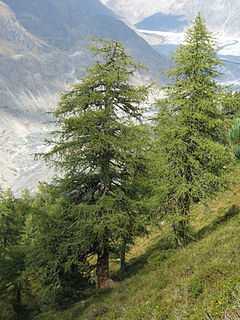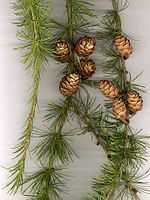Larix decidua
| Larix decidua European Larch | |
|---|---|
 | |
| European Larch in Aletschwald, Switzerland. | |
| Conservation status | |
| Scientific classification | |
| Kingdom: | Plantae |
| Division: | Pinophyta |
| Class: | Pinopsida |
| Order: | Pinales |
| Family: | Pinaceae |
| Genus: | Larix |
| Species: | L. decidua |
| Binomial name | |
| Larix decidua Mill. | |
Larix decidua, common name European larch, is a species of larch native to the mountains of central Europe, in the Alps and Carpathian Mountains, with disjunct lowland populations in northern Poland and southern Lithuania.

Description
Larix decidua is a medium-size to large deciduous coniferous tree reaching 25–45 m tall, with a trunk up to 1 m diameter (exceptionally, to 55 m tall and 2 m diameter). The crown is conic when young, becoming broad with age; the main branches are level to upswept, with the side branches often pendulous. The shoots are dimorphic, with growth divided into long shoots (typically 10–50 cm long) and bearing several buds, and short shoots only 1–2 mm long with only a single bud. The leaves are needle-like, light green, 2–4 cm long which turn bright yellow before they fall in the autumn, leaving the pale yellow-buff shoots bare until the next spring.
The cones are erect, ovoid-conic, 2–6 cm long, with 10-90 erect or slightly incurved (not reflexed) seed scales; they are green variably flushed red when immature, turning brown and opening to release the seeds when mature, 4–6 months after pollination. The old cones commonly remain on the tree for many years, turning dull grey-black.
It is very cold tolerant, able to survive winter temperatures down to at least -50°C, and is among the tree line trees in the Alps, reaching 2400 m altitude, though most abundant from 1000–2000 m. It only grows on well-drained soils, avoiding waterlogged ground.
Subspecies
There are two subspecies:
- Larix decidua subsp. decidua - European Larch or Alpine Larch. Most of the range, except as below. Cones 2.5–6 cm; shoots yellow-buff.
- Larix decidua subsp. polonica - Polish Larch. Disjunct in lowland northern Poland. Cones 2–3 cm; shoots very pale yellow-buff, almost white.
Uses
L. decidua is cultivated as an ornamental tree for planting in gardens and parks.[1]
- Wood
The wood is tough and durable, but also flexible in thin strips, and is particularly valued for yacht building; wood used for this must be free of knots, and can only be obtained from old trees that were pruned when young to remove side branches.
Small larch poles are widely used for rustic fencing.
Bonsai
The European Larch is a popular Bonsai Species, with many unique specimens available in European Circles, and is popularly used in Bonsai Forest Groups.[2]
Ecology
The seeds are an important food for some birds, notably Siskin, Lesser Redpoll and Citril Finch, while the buds and immature cones are eaten by Capercaillie.
European Larch needles are the only known food for caterpillars of the case-bearer moth Coleophora sibiricella; its cone scales are used as food by the caterpillars of the tortrix moth Cydia illutana.
Invasive species
L. decidua is classed as a wilding conifer, an invasive species which spreads into the high country of New Zealand. It was planted by the New Zealand Forest Service for erosion control.
Images
-
European Larches at dusk on the Seiser Alm, South Tyrol, Italy.
-
Early spring foliage. -
European Larch woodland in summer, Alpes-Maritimes, France.
-
Siberian Larch in autumn colour.
-

Young seed cones (red) and pollen cones (yellow).
-
European Larch planted for erosion control on a scree slope in Canterbury, New Zealand.
-
Young needles and male 'flowers' or strobili.
-
Developing seed cone in detail.
-

European Larch foliage and cones.
References
- ↑ "Larix decidua". Royal Horticultural Society. Retrieved 23 July 2013.
- ↑ D'Cruz, Mark. "Ma-Ke Bonsai Care Guide for Larix decidua". Ma-Ke Bonsai. Retrieved 2011-07-08.
| Wikimedia Commons has media related to Larix decidua. |
- Conifer Specialist Group (1998). Larix decidua. 2006. IUCN Red List of Threatened Species. IUCN 2006. www.iucnredlist.org. Retrieved on 12 May 2006.







